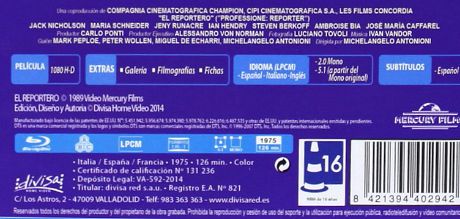A 35mm print of Michelangelo Antonioni‘s The Passenger (’75) played two nights ago at the Aero. I decided against attending, of course, because of my standard aversion to 35mm. Any print of a ’70s film carries a 75% to 80% chance of being scratched, weathered and “pink” to some extent. But the Aero screening put this 1975 classic back into my head and led to my purchasing a 2014 Spanish (Region 2) Bluray. As of now I’ve now posted the same YouTube clip of The Passenger‘s finale (7 minutes, 34 seconds) three times. The other two postings were on 6.18.13 and 4.25.14.)

From a 2006 David Thomson Guardian piece: “I can watch the world through Michelangelo Antonioni ‘s eyes forever. He is the greatest stylist of the modern era, and The Passenger may be my favorite film. No, it’s not in my top ten, but sometimes I think [The Passenger is the one I like the best, by which I fear I mean it’s the film I’d most like to be in, instead of just watching.”
From my 2013 post: “It’s soothing and nurturing to watch this shot every so often. When’s the last time a long dazzling uncut shot like this was the talk of film buffs the world over? 95% of those who live for CG-driven films would never even watch a film like The Passenger and therefore never contemplate a perfect scene like this, but if they did most would sit there like metal lawn furniture and go ‘uhm, okay, soooo…that’s it?’”
Can’t find source: “In a DVD commentary, Passenger star Jack Nicholson said Antonioni built the entire hotel so as to get this shot.
“Since the shot was continuous, it was not possible to adjust the lens aperture as the camera left the room and went into the square. Hence the footage had to be taken in the very late afternoon near dusk, in order to minimize the lighting contrast between the brightness outside and that in the room.
“The camera ran on a ceiling track in the hotel room and when it came outside the window, was meant to be picked up by a hook suspended from a giant crane nearly 30 metres high. A system of gyroscopes was fitted on the camera to steady it during the switch from this smooth indoor track to the crane outside. Meanwhile the bars on the window had been given hinges. When the camera reached the window and the bars were no longer in the field of view, they were swung away to either side.
“At this time the camera’s forward movement had to stop for a few seconds as the crane’s hook grabbed it and took over from the track. To hide this, the lens was slowly and smoothly zoomed until the crane could pull the camera forward.
“Antonioni directed the scene from a van by means of monitors and microphones, talking to assistants who communicated his instructions to the actors and operators.”

